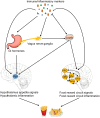An evidence review of the association of immune and inflammatory markers with obesity-related eating behaviors
- PMID: 35911732
- PMCID: PMC9336186
- DOI: 10.3389/fimmu.2022.902114
An evidence review of the association of immune and inflammatory markers with obesity-related eating behaviors
Abstract
Background: Eating behaviors contribute to disproportionate energy intake and are linked to the development of obesity. Animal studies support the role of inflammatory cytokines and chemokines in the regulation of obesity-related eating behaviors and offer a potential target to combat obesity through the modulation of inflammation. However, more complex eating behaviors are present in humans, and their relationships with immune/inflammation markers are unclear. The present study reviewed current literature to synthesize the evidence on the association of immune/inflammation markers with obesity-related eating behaviors in humans.
Methods: A systematic search of three electronic databases yielded 811 articles, of which 11 met the inclusion criteria.
Results: The majority of the included studies (91%) were either case-control or cross-sectional studies. A variety of immune/inflammation markers and obesity-related eating behaviors have been assessed in the chosen studies. Three out of four studies identified a positive relationship between C-reactive protein (CRP)/high-sensitivity CRP and loss of control eating. Other inflammatory markers that potentially have a positive relationship with obesity-related eating behaviors include fractalkine and fibrinogen. Additionally, immune molecules, including interferon gamma (INF-γ), interleukin (IL)-7, IL-10, and α-melanocyte-stimulating hormone-reactive immunoglobulin G (α-MSH/IgG) immune complex, may have negative associations with obesity-related eating behaviors. However, most findings were identified by single studies.
Conclusion: Limited studies have been conducted in humans. Current evidence indicates a potential bi-directional relationship between inflammatory/immune markers and obesity-related eating behaviors. Additional studies with sophisticated research design and comprehensive theoretical models are warranted to further delineate the relationship between immune/inflammation markers and obesity-related eating behaviors.
Keywords: cytokine; eating behavior; immune markers; inflammatory marker; obesity.
Copyright © 2022 Meng and Kautz.
Conflict of interest statement
The authors declare that the research was conducted in the absence of any commercial or financial relationships that could be construed as a potential conflict of interest.
Figures


Similar articles
-
Dietary glycation compounds - implications for human health.Crit Rev Toxicol. 2024 Sep;54(8):485-617. doi: 10.1080/10408444.2024.2362985. Epub 2024 Aug 16. Crit Rev Toxicol. 2024. PMID: 39150724
-
Modulatory Role of Omentin-1 in Inflammation: Cytokines and Dietary Intake.J Am Coll Nutr. 2016 Nov-Dec;35(8):670-678. doi: 10.1080/07315724.2015.1126207. Epub 2016 Jun 22. J Am Coll Nutr. 2016. PMID: 27331575
-
Dietary patterns and associations with biomarkers of inflammation in adults: a systematic review of observational studies.Nutr J. 2021 Mar 12;20(1):24. doi: 10.1186/s12937-021-00674-9. Nutr J. 2021. PMID: 33712009 Free PMC article.
-
The Mediating Effect of Central Obesity on the Association between Dietary Quality, Dietary Inflammation Level and Low-Grade Inflammation-Related Serum Inflammatory Markers in Adults.Int J Environ Res Public Health. 2023 Feb 21;20(5):3781. doi: 10.3390/ijerph20053781. Int J Environ Res Public Health. 2023. PMID: 36900791 Free PMC article.
-
Brain-Behavior-Immune Interaction: Serum Cytokines and Growth Factors in Patients with Eating Disorders at Extremes of the Body Mass Index (BMI) Spectrum.Nutrients. 2019 Aug 23;11(9):1995. doi: 10.3390/nu11091995. Nutrients. 2019. PMID: 31450770 Free PMC article.
Cited by
-
Association between healthy neuroticism and eating behavior as revealed by the NKI Rockland Sample.Sci Rep. 2025 Feb 18;15(1):5858. doi: 10.1038/s41598-025-85750-4. Sci Rep. 2025. PMID: 39966450 Free PMC article.
-
Dietary inflammatory index and its association with risk of metabolic syndrome and its components: a systematic review and Meta-analysis of Observational studies.J Health Popul Nutr. 2024 Jun 19;43(1):87. doi: 10.1186/s41043-024-00580-w. J Health Popul Nutr. 2024. PMID: 38898498 Free PMC article.
-
Intermittent Overconsumption of High Fat Diet Promotes Microglial Reactivity in the Hypothalamus and Hindbrain of Female Rats.Cells. 2025 Feb 6;14(3):233. doi: 10.3390/cells14030233. Cells. 2025. PMID: 39937024 Free PMC article.
-
Food addiction in patients on weight loss treatment.Front Nutr. 2024 Oct 16;11:1459274. doi: 10.3389/fnut.2024.1459274. eCollection 2024. Front Nutr. 2024. PMID: 39479189 Free PMC article.
-
Individual and Joint Association between Cardiovascular Disease Risk Factors and Inadequate Lifestyle Behaviors in a Sample from Brazil.Arq Bras Cardiol. 2024 Oct 18;121(10):e20240149. doi: 10.36660/abc.20240149. eCollection 2024. Arq Bras Cardiol. 2024. PMID: 39442139 Free PMC article. English, Portuguese.
References
-
- Fryar CD, Carroll MD, Afful J. Prevalence of overweight, obesity, and severe obesity among adults aged 20 and over: United states, 1960–1962 through 2017–2018. NCHS Health E-Stats (2020) 1–7.
-
- Hales CM, Carroll MD, Fryar CD, Ogden CL. Prevalence of obesity and severe obesity among adults: United States, 2017-2018. US Department of Health and Human Services, Centers for Disease Control and Prevention; (2020) (360):1–8.
Publication types
MeSH terms
Substances
Grants and funding
LinkOut - more resources
Full Text Sources
Medical
Research Materials
Miscellaneous

